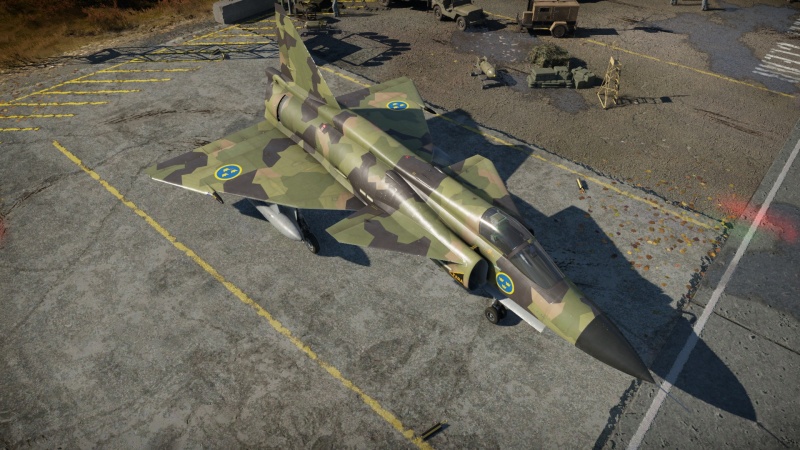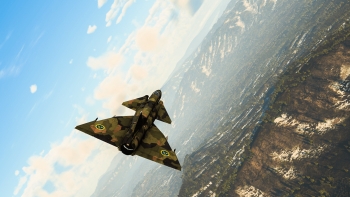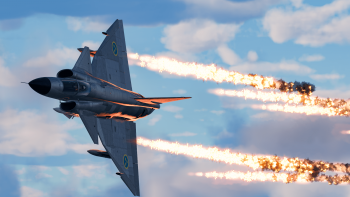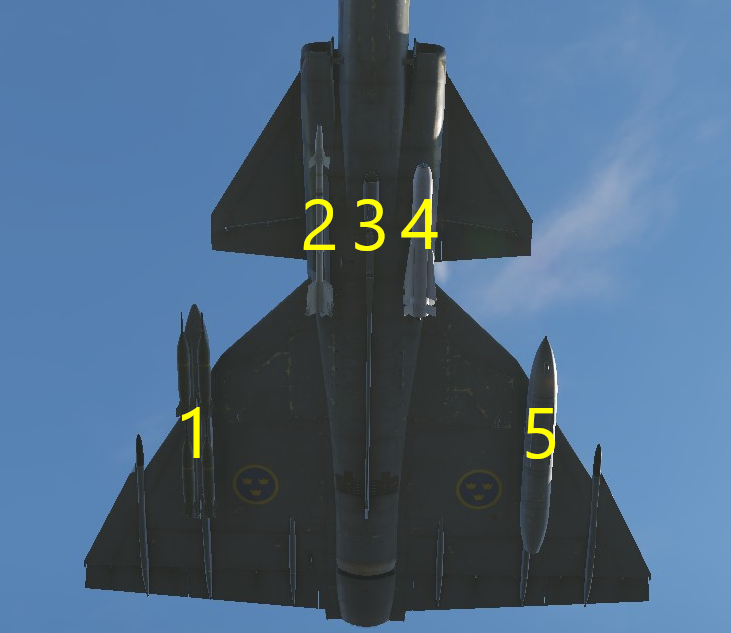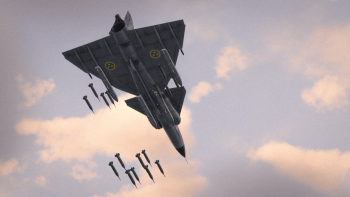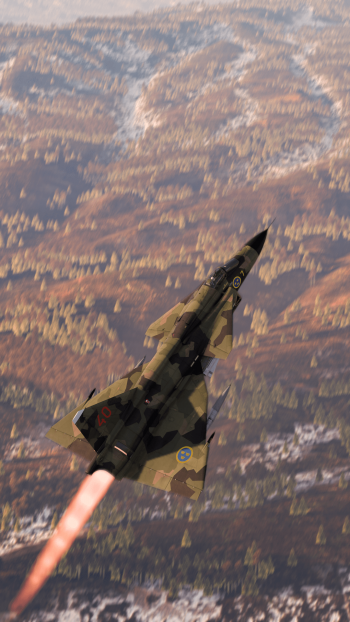AJ37
| This page is about the Swedish strike aircraft AJ37. For other versions, see SAAB 37 Viggen (Family). |
Contents
Description
The AJ37 Viggen was the ground attack variant of the SAAB 37 Viggen. The aircraft received precision guided ground weaponry, like RB 04 Anti-Ship missiles and RB 05 air to surface missiles, which will later be replaced by the AGM-65 Maverick for dealing with fortifications and enemy armour, the aircraft also received the ability to carry bombs and rockets, while retaining its capability to carry AIM-9 Sidewinder missiles for self defence. A total of 108 units were built with deliveries starting in mid 1971.
It was introduced in Update "Ground Breaking".The Swedish AJ37 is a relatively capable fighter for air battles but it is much more capable at dealing with ground targets. It features external cannons and 2 x RB24J missiles for self defence, the issue being that the cannons occupy the slots used to carry countermeasures. For ground battles, the aircrafts best weapon is the RB75 (AGM-65B Maverick) which is a very capable long range TV guided missile used against armoured units. For air battles, it has a decent flight performance, but being a very heavy airframe it suffers at low speeds, thus is very recommended staying at high speeds and only turn in favourable situations.
General info
Flight performance
Entering service in 1971, the AJ37 is almost 10 years older than the JA37C found in the fighter line beside it. Despite being almost indistinguishable from each other visually, both aircraft differ heavily in flight performance. The AJ37 is noticeably more primitive than its fighter brethren, requiring suspended ordnance to compensate for the lack of internal weapons. This, combined with the weaker powerplant, makes the AJ37 feel a lot heavier when fully kitted out. Despite this, the performance is not something to underestimate, as the Viggen platform still offers almost unmatched 'jack of all trades' performance, with excellent manoeuvrability, acceleration, and top speed.
For better or worse, flying the AJ37 is comparable to the Draken family of fighters preceding it. The overall flight performance is so extreme that most opponents the AJ37 comes across cannot keep up with it. But a trade-off is still the lack of significant energy retention. When flown recklessly, the AJ37 has a hard time keeping its speed up, which can be exploited by more powerful opponents. However, an opponent that does commit to these low speeds is likely to lose due to the low-speed handling of the Viggen. All variants, including the AJ37, come fit with flap systems designed to push air under the main wing, allowing the aircraft to manoeuvre efficiently even when stalling. Because of this, dogfighting often comes down to managing your speed, and ensuring that your manoeuvrability is better than your opponent's, either by forcing an overshoot, or baiting them into committing to a low-speed engagement.
| Characteristics | Max Speed (km/h at 9,000 m) |
Max altitude (metres) |
Turn time (seconds) |
Rate of climb (metres/second) |
Take-off run (metres) | |||
|---|---|---|---|---|---|---|---|---|
| AB | RB | AB | RB | AB | RB | |||
| Stock | 1,868 | 1,822 | 26.1 | 26.2 | 156.2 | 144.7 | 900 | |
| Upgraded | 2,017 | 1,948 | 23.9 | 25.0 | 225.4 | 190.0 | ||
Details
| Features | |||||
|---|---|---|---|---|---|
| Combat flaps | Take-off flaps | Landing flaps | Air brakes | Arrestor gear | Drogue chute |
| X | X | ✓ | ✓ | X | X |
| Limits | ||||||
|---|---|---|---|---|---|---|
| Wings (km/h) | Gear (km/h) | Flaps (km/h) | Max Static G | |||
| Combat | Take-off | Landing | + | - | ||
| 1,536 | N/A | N/A | 400 | ~12 | ~4 | |
| Optimal velocities (km/h) | |||
|---|---|---|---|
| Ailerons | Rudder | Elevators | Radiator |
| < 865 | < 700 | < 520 | N/A |
Engine performance
| Engine | Aircraft mass | |||||||
|---|---|---|---|---|---|---|---|---|
| Engine name | Number | Basic mass | Wing loading (full fuel) | |||||
| Svenska Flygmotor RM8A | 1 | 11,015 kg | 309 kg/m2 | |||||
| Engine characteristics | Mass with fuel (no weapons load) | Max Takeoff Weight | ||||||
| Weight (each) | Type | 15m fuel | 20m fuel | 30m fuel | 45m fuel | 51m fuel | ||
| 2,350 kg | Afterburning low-bypass turbofan | 12,341 kg | 12,727 kg | 13,583 kg | 14,867 kg | 15,435 kg | 19,000 kg | |
| Maximum engine thrust @ 0 m (RB/SB) | Thrust to weight ratio @ 0 m (WEP) | |||||||
| Condition | 100% | WEP | 15m fuel | 20m fuel | 30m fuel | 45m fuel | 51m fuel | MTOW |
| Stationary | 6,386 kgf | 10,520 kgf | 0.85 | 0.83 | 0.77 | 0.71 | 0.68 | 0.55 |
| Optimal | 6,386 kgf (0 km/h) |
15,255 kgf (1,250 km/h) |
1.24 | 1.20 | 1.12 | 1.03 | 0.99 | 0.80 |
Survivability and armour
Although designed with air-to-ground missions in mind, the AJ37 does not come equipped with pilot protection. Despite its size, the AJ37 is not well-suited for handling incoming damage. The fuselage is noticeably tanky, but due to the large engine and control surfaces, the likelihood of surviving hits without consequence is fairly small.
Modifications and economy
Armaments
| Ballistic Computer | |||
|---|---|---|---|
| CCIP (Guns) | CCIP (Rockets) | CCIP (Bombs) | CCRP (Bombs) |
| |
|
|
|
Suspended armament
The AJ37 can be outfitted with the following ordnance:
| 1 | 2 | 3 | 4 | 5 | ||
|---|---|---|---|---|---|---|
| 30 mm Akan m/55 cannons (150 rpg) | 1 | 1 | ||||
| 120 kg m/71 bombs | 4 | 4 | 4 | 4 | ||
| psrak m/70 rockets | 6 | 6 | 6 | 6 | ||
| RB24 missiles | 1 | 1 | ||||
| RB24J missiles | 1 | 1 | ||||
| RB 75 missiles | 1 | 1 | ||||
| Rb05A missiles | 1 | 1 | ||||
| Countermeasures | 24 | 24 | ||||
| 1,250 l drop tanks | 1 |
| Default weapon presets | |
|---|---|
| |
The stock loadouts on the AJ37 allow for either gunpods or air-to-air missiles. The performance of the RB24J often allows two guaranteed air kills, which can be important when spading the aircraft. However, more skilled pilots might find more use out of the Akan gun pods as they can down significantly more aircraft in one go and still engage ground targets if needed. They can be somewhat tricky to get used to, however, as they are spaced out from the center of the aircraft, both horizontally and vertically.
The m/70 rockets are the only air-to-ground ordnance shared with the JA37C. The rockets allow for great precision attacks from far range thanks to the ballistic computer, and due to the large explosive filler, a single accurate hit is more than enough to deal with any armoured threat. The rocket placement can be somewhat tricky as they are not centred with the aircraft, similar to the gun pods.
The Rb05A is unique in its class, as this manually guided air-to-ground missile features a proximity fuze for attacking airborne threats. Although very unconventional to use, this missile is highly potent in ground battles, as the explosive can kill any tank it hits, while also destroying helicopters with ease if needed.
The RB 75 is identical to the AGM-65A found on other aircraft and performs equally well. This air-to-ground missile uses optical guidance to distinguish targets, allowing it to guide itself after launch. Since the missile is capable of gliding up to 20 km of distance, altitude is preferred when deploying for the best distance and target visibility. When employed correctly, the AJ37 can safely stay away from SAM systems while engaging ground vehicles.
The countermeasures used by the AJ37 are carried in two pods, one on each wing. Both come equipped with 24 slots each, dispensing in unison when activated. These flares require some manoeuvring and throttle management to deploy efficiently, especially since the direction they dispense is straight behind the nozzle. Cutting afterburner and banking slightly is always optimal when flaring, and will throw off most heat-seeking missiles.
The 120 kg m/71s are the only type of bombs found on this aircraft. Carried in groups of four, these bombs are dispensed singularly starting from the left. Their limited explosive mass makes them fairly inefficient at destroying bases in air battles. However, the precision offered by the ballistic computer allows for plenty of stopping power against ground vehicles. These bombs are also a lot safer to use than unguided rockets, as they do not require the pilot to look directly at the target.
Usage in battles
Air Realistic Battles
- Always carry RB24Js, flares, and guns
- Take as much fuel as possible
- Avoid higher altitudes
- Stay as fast as possible when engaging aircraft
- Use RWR to notch enemy radar missiles when uptiered
- Use flares reinforced
The AJ37 has no limitations when it comes to flight performance. The acceleration, manoeuvrability, and top speed outclasses almost any aircraft it faces, giving it plenty of wiggle room for engaging anything it wants. With the addition of custom loadouts, the AJ37 is now able to carry a gunpod and flare pod simultaneously. The downside lies in the suspended weaponry, which is very limited for a plane its size. These downsides are entirely dependent on the opponents a pilot is going against, as some aircraft might have even less to work with than the AJ37, making them easy prey. In downtiers, the AJ37 can become unstoppable as the armament becomes secondary. Since the AJ37 is one of the best handling supersonic aircraft, facing subsonic and transonic opponents is a walk in the park. When facing these sorts of aircraft, firepower should always be prioritized to maximize the amount of damage the plane can put out. Here, a pilot should focus on going straight in, keeping opponents busy for allied teammates.
When facing more potent opponents, however, especially those at higher tiers, the lacklustre weaponry becomes apparent. The AJ37 carries half the expected amount of missiles and has no all-aspect capability. On top of this, opponents at this tier often carry potent missiles that require flares to properly avoid. A loadout with flares, RB24J missiles, and a gun pod is necessary. In these matches, it's imperative to stick to teammates or focus on a lone enemy plane.
Ground Realistic Battles
- Use countermeasures when facing SAM systems
- Use suspended weaponry of your choice
- Gain altitude quickly when using RB 75
- Stay as low and fast as possible when using rockets, bombs, cannons, or the Rb05As
Using the AJ37 for its intended purpose can sometimes be trickier than fighting aircraft, especially due to the prominent threat of SAM systems. The AJ37 is much more potent compared to the earlier A32A in almost every regard, but that does not make it immune to anti-air equipment. The best way to counter SAM systems is by flying at high speeds while deploying chaff simultaneously. This forces radar locks to reset, allowing for short timeframes of efficient ground striking. Staying above Mach is almost a requirement, unless terrain can be worked with to avoid sightlines with the SAM launcher. A more daring tactic is to forego countermeasures altogether, and focusing on destroying the SAM system before it even locates the aircraft. This allows for more variety in the suspended ordnance, doubling the number of bombs or rockets, or allowing the use of Akans to combat air targets at the same time.
This mentality does not apply when using the RB 75, as this missile allows for much further distance when engaging. With over 20 km of launch range, the Maverick missile is able to stay out of the range of ground-based SAM equipment, while still engaging ground targets. The optimal strategy here is to gain altitude directly after spawning, trying to separate a great distance from the battlefield. A great way to check for optimal distance is watching the capture-point marker that tells distance, as it gives a rough estimate of your current range. When beyond 12 km, the average distance a SAM system can reach, a pilot can begin checking for targets on the ground through the sight. Once a target is acquired, turn back and repeat the process. Due to the limited armament, it can be quite handy to carry a second ordnance option or to simply climb near the airfield for quick rearming.
| Remember to check for helicopters when using the Rb05A missile! The proximity fuze allows for them to be easily taken down. |
Pros and cons
Pros:
- Powerful 30 mm guns in gun pods
- Excellent top speed, especially at lower altitudes
- Access to RB 75 air-to-ground missiles (AGM-65A equivalent)
- Access to RB24J (AIM-9P equivalent performance)
- Incredible manoeuvrability at all speeds
- Powerful radar
- Easy to land - Access to thrust reversing
Cons:
- Limited armament options - Only able to carry up to two weapon types, on four pylons
- Poor energy retention at lower speeds
- Countermeasure pod replaces a weapon pylon
- Only small bombs are available
- Limited burst mass and range on 30 mm Akan - Outclassed by 20 mm Vulcan
- Awkward cannon placement - Suspended gun pods are spread out and low mounted
- No radar missiles are available
- Afterburner drains fuel quickly (1:10 ratio)
History
Describe the history of the creation and combat usage of the aircraft in more detail than in the introduction. If the historical reference turns out to be too long, take it to a separate article, taking a link to the article about the vehicle and adding a block "/History" (example: https://wiki.warthunder.com/(Vehicle-name)/History) and add a link to it here using the main template. Be sure to reference text and sources by using <ref></ref>, as well as adding them at the end of the article with <references />. This section may also include the vehicle's dev blog entry (if applicable) and the in-game encyclopedia description (under === In-game description ===, also if applicable).
Media
- Skins
- Videos
See also
Swedish Delta-winged Aircraft
Comparable aircraft
External links
| Swedish Aeroplane Company Ltd. (SAAB) | |
|---|---|
| Pre-SAAB: SA / ASJA | |
| SA 'Jaktfalken' | J6B |
| SAAB 17 | B17A · B17B · S17BS |
| SAAB 18 | B18A · B18B · T18B · T18B (57) |
| SAAB 21 | J21A-1 · J21A-2 · A21A-3 · J21RA · A21RB |
| SAAB 29 'Tunnan' | J29A · A29B · J29D · J29F |
| SAAB 32 'Lansen' | J32B · A32A · A32A Röd Adam |
| SAAB 35 'Draken' | J35A · J35D |
| SAAB 37 'Viggen' | JA37C · JA37D · JA37DI · JA37DI F21 · AJ37 · AJS37 |
| SAAB 39 'Gripen' | JAS39A · JAS39C |
| SAAB 105 | SK60B · SAAB-105G |
| License Production | B3C (Ju 86K) |
| Export | SAAB-105OE · J35XS · ▄JAS39C · ◔JAS39EBS HU C |
| Sweden jet aircraft | |
|---|---|
| Fighters | J21RA |
| J29A · A29B · J29D · J29F | |
| J32B | |
| J34 | |
| J35A · J35D | |
| JA37C · JA37D · JA37DI · JA37DI F21 | |
| JAS39A · JAS39C | |
| Strike aircraft | A21RB |
| A32A · A32A Röd Adam | |
| A28B | |
| AJ37 · AJS37 | |
| SK60B · SAAB-105G | |
| Export | SAAB-105OE |
| Finland | ▄Vampire FB 52A · ▄MiG-21bis · Saab J35XS |



